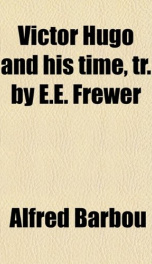victor hugo and his time

Purchase of this book includes free trial access to www.million-books.com where you can read more than a million books for free. This is an OCR edition with typos. Excerpt from book: CHAPTER III. The house in the Impasse des FeuillantinesTho gardenVictor Hugo's own reminiscencesMaternal instructionPortrait of Madame HugoOhedience enforced upon the childrenThe school and the cuI-tle-sac General Lahorie His commentary on TacitusHis arrest and executionDeparture for Spain. At the end of a kind of eul-de-sac, called the Impasse des Feuillantines, stood No. 12, the house to which reference has just been made. In his own writings Victor Hugo has several times referred to the place in terms that we shall presently quote; but he has also given the writer of the present biography a verbal description of some of the leading features of the dwelling where he passed a certain period of his early years. He can still picture the handsome grilled gateway that had to be passed before entering the courtyard leading to the front door. On the right hand of the door and on the same level was an apartment that served as a play-room in rainy weather. Immediately facing the door was a short staircase that led up to the salon, through which, on the left, there was access to Madame Hugo's own room, which, in its turn, opened into another room assigned to the children. By the side of these were two more apartments, one of them the dining-room, the other reserved as a spare bedroom. The salon was both spacious and lofty. At the farther end of it was a flight of steps leading down to the garden. Beneath the windows were beds of the flowers to which Madame Hugo was partial, and to the left of the flower-beds was a piece of waste land full of holes and excavations, in the middle of which was a " puisard," a kind of shallow basin, but not containing any water. Here young Victor daily set snares, each in its turnmore ingenious than the last, to catch a salamander, that ma...
Info about the book
Author:
Series:
Unknown
ASIN:
B004SVPHLY
Rating:
3/5 (2)Your rating:
0/5
Languge:
English
Users who have this book
Users who want this book
What readers are saying
What do you think? Write your own comment on this book!
write a commentif you like victor hugo and his time try:
Other books by this author
Do you want to read a book that interests you? It’s EASY!
Create an account and send a request for reading to other users on the Webpage of the book!


